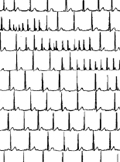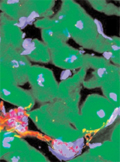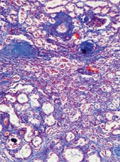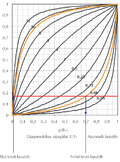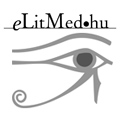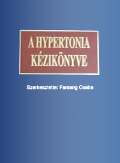The eLitMed.hu medical portal uses computer cookies for convenient operation. Detailed information can be found in the Cookie-policy.
Lege Artis Medicinae - 2011;21(03)
Content
[ECG artefacts]
[The recognition of ECG artefacts is becoming increasingly important for physicians working in the field of internal medicine. At the same time, however, very little information about artefacts is published in either articles or textbooks. The authors provide a summary of the generation, types and recognition of ECG artefacts. The aim of the article is to draw the attention of clinicians to the dangers of this increasingly common phenomenon. Unrecognised artefacts can often prompt further (unnecessary) investigations and may result in establishing wrong diagnosis as well as erroneous treatment decisions.]
[Treatment of cardiovascular risk of patients with hypertension: the role of fixed combination amlodipin-atorvastatin therapy in light of recent studies]
[Risk factors for cardiovascular disease commonly coexist in patients with hypertension: high blood pressure is accompanied by alterations of lipid and glucose metabolism, obesity or smoking in the vast majority (70-80%) of patients. In the presence of multiple risk factors, the increment of relative cardiovascular risk caused by individual risk factors is not additive but multiplied. Since the ASCOT trial was published, statin therapy is recommended to every hypertensive patients with LDL cholesterol >2.5 mmol/L and at least intermediate cardiovascular risk (Euro SCORE>3%). Some studies show, however, that in daily clinical practice, blood pressure and lipid targets are achieved in a small percentage of patients with hypertension and dyslipidaemia. This is partly due to the fact that borderline alterations of serum cholesterol and their risk-increasing effects are often neglected during the planning of the therapy, and therapeutic adherence and persistence of patients are insufficient. According to new studies, both factors can be improved significantly if the antihypertensive and lipid-lowering treatments are initiated simultaneously, using a single pill with dual effect.]
[New treatment option for oral anticoagulation in the prevention of cardiogenic stroke - Focus on the RE-LY trial]
[Atrial fibrillation (AF) represents the most common cause of cardioembolic stroke. The prevalence of AF increases with age and affects 10% of elderly people. AF-related stroke is usually severe and has a high mortality. The risk of stroke can be estimated on the basis of risk factors accompanying AF and age. Patients with one of the highest risk are those with AF and previous TIA or stroke. Efficient prevention is achieved by chronic anticoagulation therapy. In clinical practice, the use of vitamin K antagonists (VKA) has been the only option. The use of these agents is limited for a number of reasons, and clinicians are especially reluctant to use them in elderly patients at high risk of stroke. Consequently, of the patients with AF for whom anticoagulant therapy is indicated, only about 50-60% receives such therapy, and only half of the treated patients achieves target INR values. More than 50 years after the introduction of warfarin, data of trials with the new direct thrombin inhibitor dabigatran have been published in the past few years. In this paper, we review the results of the phase III, international RE-LY trial, published in 2009, which evaluated the preventive efficacy dabigatran etexilate in patients with AF compared with warfarin at a therapeutic dose. On the basis of the results, dabigatran used at a dose of 2×110mg daily provides the same protection as warfarin, whereas at a dose of 2×150mg it provides a signiificantly more efficient protection from AF-associated stroke and systemic embolism. In addition to its excellent preventive effect, dabigatran tretament results in a significant decrease in the risk of intracranial haemorrhages, and of other major haemorrhages. On the basis of the results, dabigatran will probably change the current treatment paradigm in the stroke prevention in patients with AF, and its introduction can substantially increase the number of patients treated efficiently and safely.]
[Analysis of short-term and long-term survival and causes of death in patients with systemic lupus erythematosus]
[INTRODUCTION - In systemic lupus erythematosus (SLE), both short-term and long-term survival rates have improved worldwide. We analysed retrospectively the short-term and long-term survival data and causes of death at a single center. These data were compared with previous survival data recorded at the same centre and published in international studies. PATIENTS AND METHOD - The data of 550 patients with SLE were analysed between 1970 and 2009. We examined the effect of clinical symptoms, age, severity and onset of the disease and the applied immunosuppressive treatment on survival, using the Kaplan-Meier method. RESULTS - Survival rates at 5, 10, 15 and 20 years after the diagnosis were 98%, 94%, 90% and 89%, respectively. Late onset, neuropsychiatric symptoms and severe SLE were found to be prognostic factors. Manifestations affecting other organs and the applied immunosuppressive therapy did not influence survival rates. During the study period, 57 out of the 550 patients (10.4%) died. The main causes of death were cardiovascular complications (50.9%), infections (21%), and malignancies (12.3%). CONCLUSIONS - Our results show that among patients with SLE, it is mostly longterm survival that has increased, owing to the close control of patients. The increase in cardiovascular mortality highlights the importance of regular screening.]
[Perindopril plus Indapamid CombinAtion blood preSSure reductiOn study (PICASSO)]
[INTRODUCTION - International and Hungarian (JNC-7, ESH/ESC2007 és 2009, MHT 2009) Guidelines suggest a target blood pressure <140/90 mmHg for hypertensive patients, and <130/80 mmHg for those with high/very high cardiovascular risk (e.g. patients with diabetes mellitus, chronic renal disease). It was proved that for achieving the most efficient antihypertensive effect and reducing side effects, thd use of drug combinations is needed in most patients. In Hungary, ACE-inhibitor plus diuretic combination is one of the most frequently used one in Hungary. The aim of the PICASSO study was to evaluate the efficacy and metabolic effects of the fixed combination of high-dose perindopril plus indapamide (Coverex-AS Komb Forte®) in clinical practice of hypertonologists, cardiologists and general practicioners. PATIENTS AND METHODS - Patients with uncontrolled, grade 1 or 2 primary hypertension, age, >18years were involved in the open, 3-month, multicentre, prospective, observational, non-interventional clinical study if the treating physician indicated a combination treatment with higher dose antihypertensive drugs. Blood pressure (also with ABPM), heart rate, metabolic parameters (plasma lipids, blood sugar, Na, K, creatinine, uric acid, GGT) were measured by routine methods, medical history and quality of life parameters were registered on a validated questionnaire. Changes in the above parameters were also separately evaluated in patients with different risk factors or with concomitant diseases. RESULTS - Data of 9683 patients were evaluated (54% women, 46% men, average age 61.8 years). By the end of the therapy used in the study, blood pressure average decreased from 159/93 to 131/80, by ABPM from 145/83 to 126/74 mmHg (24hr averages, systolic/diastolic blood pressure, respectively), the heart rate from 79 to 73 beats/min (p<0,001). Target blood pressure was achieved in 75,4% of patients with no major concomitant disease, but only in 14% of those with a concomitant disease characterised by lower target blood pressure. The diurnal index by ABPM did not change substantially. Clinically significant decreases were found in the plasma levels of total cholesterol, LDL-cholesterol, triglycerides, fasting glucose and uric acid levels, but there were no major changes in serum levels of HDL-cholesterol, Na, K, and GGT. Quality of life parameters significantly improved by the end of the study. CONCLUSIONS - Combinations of perindopril and indapamide can be successfully and safely used in everyday practice.]
[Creatine deficiency - a possible cause of mental retardation]
[Creatine plays a major role in the energy supply of brain and muscle tissues. In creatine deficiency states, insufficient energy supply of the brain tissue may lead to mental retardation with speech delay and behavioural problems, epilepsy and extrapyramidal symptoms, while that of the muscle tissue might result in hypotonia. Creatine deficiency has been shown to result either from dysfunction of the two enzymes involved in its synthesis, namely arginine:glycine amidinotransferase and guanidinoacetic methyltransferase, or from impairment of the SLC6A8 transporter protein that is responsible for the cellular uptake of creatine. Synthesis disorders can be efficiently treated by creatine supplementation. The therapy is the most efficient if it is started in time, before the development of irreversible damages. Thus, in case of mental retardation associated with delayed speech development or behavioural problems, or epilepsy of unknown origin, diagnostic tests for creatine deficiency are recommended as early as possible. In creatine-transport disorder, the results of treatments to increase the intracellular creatine pool are controversial]
[JAK2 V617F: a new risk factor of stent thrombosis?]
[INTRODUCTION - Although the introduction of stents has dramatically improved the efficiency of percutaneous coronary interventions, a new complication, the stent thrombosis has appeared. Owing to intensive research, the incidence of this previously common complication is currently 1%. Because of the high mortality and morbidity, it is important to find more and more predictors, which might help to further reduce the incidence. CASE REPORT - Our elderly male patient presented with acute anterior myocardial infarct. Stent implantation of the left anterior descendent branch was performed using coronarography, with no complications. After five days without any symptoms, ST elevation recurred and subacute stent thrombosis was deteceted. Because of the laboratory results showing thrombocytosis, we performed JAK2 V617F screening, with a positive result. Prolonged heparin therapy, platelet aggegation inhibition at a transiently elevated dose and hydroxyurea treatment because of the myeloproliferativ malignancy were used. At the follow-up visit, the patient did not report any complaints, and cell counts for all three myeloid cell lines were in the normal range. CONCLUSION - The thrombogenic feature of the classic myeloproliferative disorders is well-known, and JAK2 V617F mutations further increase the risk. In our departement, screeing for such genetic alteration was performed in patients with stent thrombosis and a platelet count higher than 450 G/l. Two of the three cases had positive results. Supported by the literature, we think that the hematologic disease lead to the thrombotic complication in our patients. In our opinion, the JAK2 V617F is a potential risk factor of stent thrombosis.]
1.
Clinical Neuroscience
Is there any difference in mortality rates of atrial fibrillation detected before or after ischemic stroke?2.
Clinical Neuroscience
Factors influencing the level of stigma in Parkinson’s disease in western Turkey3.
Clinical Neuroscience
Neuropathic pain and mood disorders in earthquake survivors with peripheral nerve injuries4.
Journal of Nursing Theory and Practice
[Correlations of Sarcopenia, Frailty, Falls and Social Isolation – A Literature Review in the Light of Swedish Statistics]5.
Clinical Neuroscience
[Comparison of pain intensity measurements among patients with low-back pain]1.
Clinical Neuroscience Proceedings
[A Magyar Stroke Társaság XVIII. Kongresszusa és a Magyar Neuroszonológiai Társaság XV. Konferenciája. Absztraktfüzet]2.
3.
Journal of Nursing Theory and Practice
[A selection of the entries submitted to the literary contest "Honorable mission: the joys and challenges of our profession" ]4.
Journal of Nursing Theory and Practice
[End of Life and Palliative Care of Newborns in the Nursing Context]5.
Journal of Nursing Theory and Practice
[Aspects of Occupational Health Nursing for Incurable Patients ]